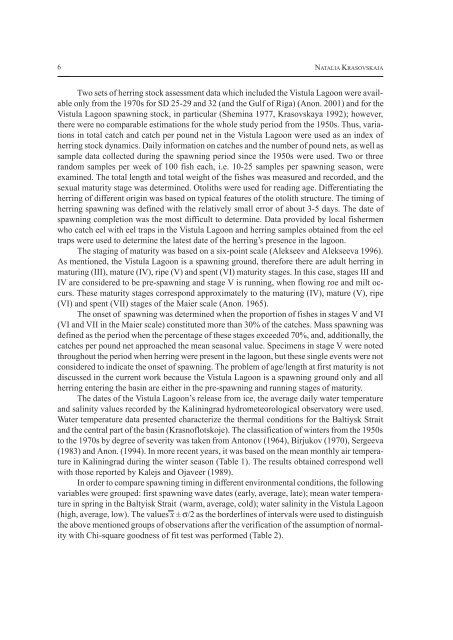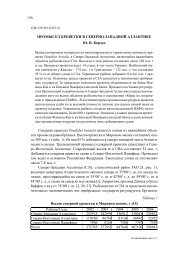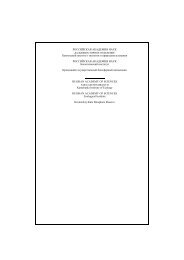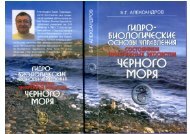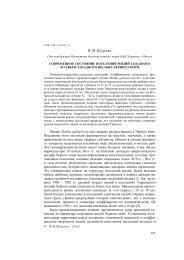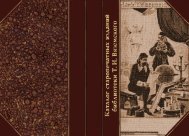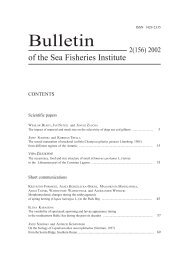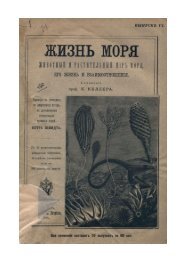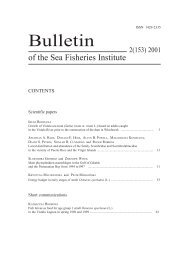Bulletin of the Sea Fisheries Institute 1 (155) 2002 - CEEMaR
Bulletin of the Sea Fisheries Institute 1 (155) 2002 - CEEMaR
Bulletin of the Sea Fisheries Institute 1 (155) 2002 - CEEMaR
Create successful ePaper yourself
Turn your PDF publications into a flip-book with our unique Google optimized e-Paper software.
6<br />
NATALIA KRASOVSKAJA<br />
Two sets <strong>of</strong> herring stock assessment data which included <strong>the</strong> Vistula Lagoon were available<br />
only from <strong>the</strong> 1970s for SD 25-29 and 32 (and <strong>the</strong> Gulf <strong>of</strong> Riga) (Anon. 2001) and for <strong>the</strong><br />
Vistula Lagoon spawning stock, in particular (Shemina 1977, Krasovskaya 1992); however,<br />
<strong>the</strong>re were no comparable estimations for <strong>the</strong> whole study period from <strong>the</strong> 1950s. Thus, variations<br />
in total catch and catch per pound net in <strong>the</strong> Vistula Lagoon were used as an index <strong>of</strong><br />
herring stock dynamics. Daily information on catches and <strong>the</strong> number <strong>of</strong> pound nets, as well as<br />
sample data collected during <strong>the</strong> spawning period since <strong>the</strong> 1950s were used. Two or three<br />
random samples per week <strong>of</strong> 100 fish each, i.e. 10-25 samples per spawning season, were<br />
examined. The total length and total weight <strong>of</strong> <strong>the</strong> fishes was measured and recorded, and <strong>the</strong><br />
sexual maturity stage was determined. Otoliths were used for reading age. Differentiating <strong>the</strong><br />
herring <strong>of</strong> different origin was based on typical features <strong>of</strong> <strong>the</strong> otolith structure. The timing <strong>of</strong><br />
herring spawning was defined with <strong>the</strong> relatively small error <strong>of</strong> about 3-5 days. The date <strong>of</strong><br />
spawning completion was <strong>the</strong> most difficult to determine. Data provided by local fishermen<br />
who catch eel with eel traps in <strong>the</strong> Vistula Lagoon and herring samples obtained from <strong>the</strong> eel<br />
traps were used to determine <strong>the</strong> latest date <strong>of</strong> <strong>the</strong> herring’s presence in <strong>the</strong> lagoon.<br />
The staging <strong>of</strong> maturity was based on a six-point scale (Alekseev and Alekseeva 1996).<br />
As mentioned, <strong>the</strong> Vistula Lagoon is a spawning ground, <strong>the</strong>refore <strong>the</strong>re are adult herring in<br />
maturing (III), mature (IV), ripe (V) and spent (VI) maturity stages. In this case, stages III and<br />
IV are considered to be pre-spawning and stage V is running, when flowing roe and milt occurs.<br />
These maturity stages correspond approximately to <strong>the</strong> maturing (IV), mature (V), ripe<br />
(VI) and spent (VII) stages <strong>of</strong> <strong>the</strong> Maier scale (Anon. 1965).<br />
The onset <strong>of</strong> spawning was determined when <strong>the</strong> proportion <strong>of</strong> fishes in stages V and VI<br />
(VI and VII in <strong>the</strong> Maier scale) constituted more than 30% <strong>of</strong> <strong>the</strong> catches. Mass spawning was<br />
defined as <strong>the</strong> period when <strong>the</strong> percentage <strong>of</strong> <strong>the</strong>se stages exceeded 70%, and, additionally, <strong>the</strong><br />
catches per pound net approached <strong>the</strong> mean seasonal value. Specimens in stage V were noted<br />
throughout <strong>the</strong> period when herring were present in <strong>the</strong> lagoon, but <strong>the</strong>se single events were not<br />
considered to indicate <strong>the</strong> onset <strong>of</strong> spawning. The problem <strong>of</strong> age/length at first maturity is not<br />
discussed in <strong>the</strong> current work because <strong>the</strong> Vistula Lagoon is a spawning ground only and all<br />
herring entering <strong>the</strong> basin are ei<strong>the</strong>r in <strong>the</strong> pre-spawning and running stages <strong>of</strong> maturity.<br />
The dates <strong>of</strong> <strong>the</strong> Vistula Lagoon’s release from ice, <strong>the</strong> average daily water temperature<br />
and salinity values recorded by <strong>the</strong> Kaliningrad hydrometeorological observatory were used.<br />
Water temperature data presented characterize <strong>the</strong> <strong>the</strong>rmal conditions for <strong>the</strong> Baltiysk Strait<br />
and <strong>the</strong> central part <strong>of</strong> <strong>the</strong> basin (Krasn<strong>of</strong>lotskoje). The classification <strong>of</strong> winters from <strong>the</strong> 1950s<br />
to <strong>the</strong> 1970s by degree <strong>of</strong> severity was taken from Antonov (1964), Birjukov (1970), Sergeeva<br />
(1983) and Anon. (1994). In more recent years, it was based on <strong>the</strong> mean monthly air temperature<br />
in Kaliningrad during <strong>the</strong> winter season (Table 1). The results obtained correspond well<br />
with those reported by Kalejs and Ojaveer (1989).<br />
In order to compare spawning timing in different environmental conditions, <strong>the</strong> following<br />
variables were grouped: first spawning wave dates (early, average, late); mean water temperature<br />
in spring in <strong>the</strong> Baltyisk Strait (warm, average, cold); water salinity in <strong>the</strong> Vistula Lagoon<br />
(high, average, low). The values x ± σ/2 as <strong>the</strong> borderlines <strong>of</strong> intervals were used to distinguish<br />
<strong>the</strong> above mentioned groups <strong>of</strong> observations after <strong>the</strong> verification <strong>of</strong> <strong>the</strong> assumption <strong>of</strong> normality<br />
with Chi-square goodness <strong>of</strong> fit test was performed (Table 2).


